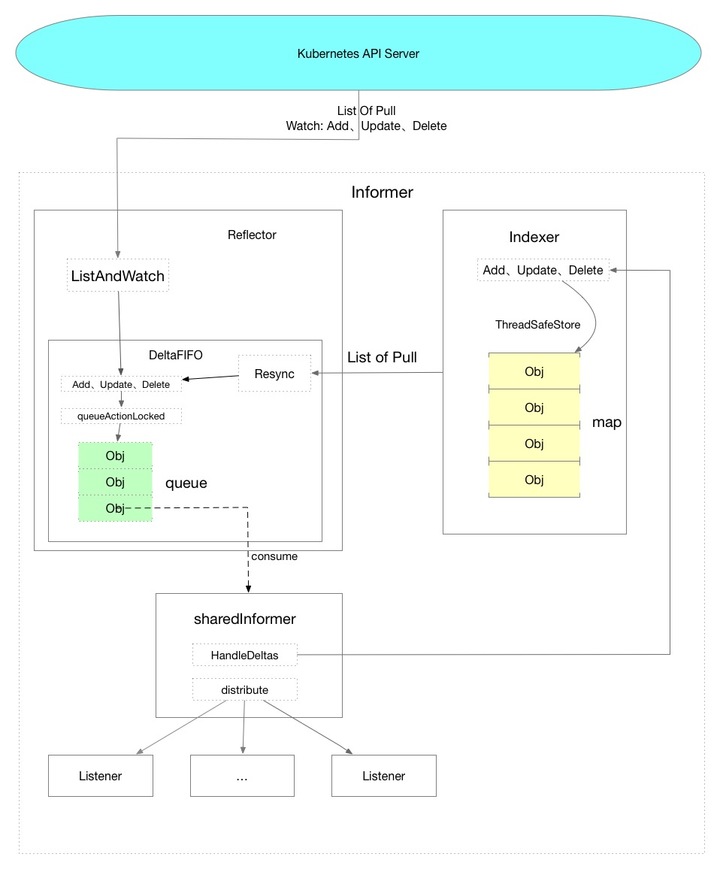您好,登錄后才能下訂單哦!
您好,登錄后才能下訂單哦!
今天就跟大家聊聊有關如何解析client-go中workqueue,可能很多人都不太了解,為了讓大家更加了解,小編給大家總結了以下內容,希望大家根據這篇文章可以有所收獲。
下面主要講述下client-go中workqueue, 看一下client-go的一個整體數據走向.如下圖:

而workqueue主要是在listener這里引用,listener使用chan獲取到數據之后將數據放入到工作隊列進行處理。主要是由于chan過于簡單,已經無法滿足K8S的場景,所以衍生出了workqueue,
特性
有序
去重
并發
延遲處理
限速
當前有三種workqueue
基本隊列
延遲隊列
限速隊列
其中延遲隊列是基于基本隊列實現的,而限流隊列基于延遲隊列實現
基本隊列
看一下基本隊列的接口
// client-go源碼路徑util/workqueue/queue.go
type Interface interface {
//新增元素 可以是任意對象
Add(item interface{})
//獲取當前隊列的長度
Len() int
// 阻塞獲取頭部元素(先入先出) 返回元素以及隊列是否關閉
Get() (item interface{}, shutdown bool)
// 顯示標記完成元素的處理
Done(item interface{})
//關閉隊列
ShutDown()
//隊列是否處于關閉狀態
ShuttingDown() bool
}看一下基本隊列的數據結構,只看三個重點處理的,其他的沒有展示出來
type Type struct {
//含有所有元素的元素的隊列 保證有序
queue []t
//所有需要處理的元素 set是基于map以value為空struct實現的結構,保證去重
dirty set
//當前正在處理中的元素
processing set
...
}
type empty struct{}
type t interface{}
type set map[t]empty基本隊列的hello world也很簡單
wq := workqueue.New()
wq.Add("hello")
v, _ := wq.Get()基本隊列Add
func (q *Type) Add(item interface{}) {
q.cond.L.Lock()
defer q.cond.L.Unlock()
//如果當前處于關閉狀態,則不再新增元素
if q.shuttingDown {
return
}
//如果元素已經在等待處理中,則不再新增
if q.dirty.has(item) {
return
}
//添加到metrics
q.metrics.add(item)
//加入等待處理中
q.dirty.insert(item)
//如果目前正在處理該元素 就不將元素添加到隊列
if q.processing.has(item) {
return
}
q.queue = append(q.queue, item)
q.cond.Signal()
}基本隊列Get
func (q *Type) Get() (item interface{}, shutdown bool) {
q.cond.L.Lock()
defer q.cond.L.Unlock()
//如果當前沒有元素并且不處于關閉狀態,則阻塞
for len(q.queue) == 0 && !q.shuttingDown {
q.cond.Wait()
}
...
item, q.queue = q.queue[0], q.queue[1:]
q.metrics.get(item)
//把元素添加到正在處理隊列中
q.processing.insert(item)
//把隊列從等待處理隊列中刪除
q.dirty.delete(item)
return item, false
}基本隊列實例化
func newQueue(c clock.Clock, metrics queueMetrics, updatePeriod time.Duration) *Type {
t := &Type{
clock: c,
dirty: set{},
processing: set{},
cond: sync.NewCond(&sync.Mutex{}),
metrics: metrics,
unfinishedWorkUpdatePeriod: updatePeriod,
}
//啟動一個協程 定時更新metrics
go t.updateUnfinishedWorkLoop()
return t
}
func (q *Type) updateUnfinishedWorkLoop() {
t := q.clock.NewTicker(q.unfinishedWorkUpdatePeriod)
defer t.Stop()
for range t.C() {
if !func() bool {
q.cond.L.Lock()
defer q.cond.L.Unlock()
if !q.shuttingDown {
q.metrics.updateUnfinishedWork()
return true
}
return false
}() {
return
}
}
}延遲隊列
延遲隊列的實現思路主要是使用優先隊列存放需要延遲添加的元素,每次判斷最小延遲的元素書否已經達到了加入隊列的要求(延遲的時間到了),如果是則判斷下一個元素,直到沒有元素或者元素還需要延遲為止。
看一下延遲隊列的數據結構
type delayingType struct {
Interface
...
//放置延遲添加的元素
waitingForAddCh chan *waitFor
...
}主要是使用chan來保存延遲添加的元素,而具體實現是通過一個實現了一個AddAfter方法,看一下具體的內容
//延遲隊列的接口
type DelayingInterface interface {
Interface
// AddAfter adds an item to the workqueue after the indicated duration has passed
AddAfter(item interface{}, duration time.Duration)
}
func (q *delayingType) AddAfter(item interface{}, duration time.Duration) {
...
//如果延遲實現小于等于0 直接添加到隊列
if duration <= 0 {
q.Add(item)
return
}
select {
case <-q.stopCh:
//添加到chan,下面會講一下這個chan的處理
case q.waitingForAddCh <- &waitFor{data: item, readyAt: q.clock.Now().Add(duration)}:
}
}延遲元素的處理
func (q *delayingType) waitingLoop() {
defer utilruntime.HandleCrash()
never := make(<-chan time.Time)
var nextReadyAtTimer clock.Timer
waitingForQueue := &waitForPriorityQueue{}
//這里是初始化一個優先隊列 具體實現有興趣的同學可以研究下
heap.Init(waitingForQueue)
waitingEntryByData := map[t]*waitFor{}
for {
if q.Interface.ShuttingDown() {
return
}
now := q.clock.Now()
// Add ready entries
for waitingForQueue.Len() > 0 {
entry := waitingForQueue.Peek().(*waitFor)
//看一下第一個元素是否已經到達延遲的時間了
if entry.readyAt.After(now) {
break
}
//時間到了,將元素添加到工作的隊列,并且從延遲的元素中移除
entry = heap.Pop(waitingForQueue).(*waitFor)
q.Add(entry.data)
delete(waitingEntryByData, entry.data)
}
// Set up a wait for the first item's readyAt (if one exists)
nextReadyAt := never
if waitingForQueue.Len() > 0 {
if nextReadyAtTimer != nil {
nextReadyAtTimer.Stop()
}
//如果還有需要延遲的元素,計算第一個元素的延遲時間(最小延遲的元素)
entry := waitingForQueue.Peek().(*waitFor)
nextReadyAtTimer = q.clock.NewTimer(entry.readyAt.Sub(now))
nextReadyAt = nextReadyAtTimer.C()
}
select {
case <-q.stopCh:
return
case <-q.heartbeat.C():
//定時檢查下是否有元素達到延遲的時間
case <-nextReadyAt:
//這里是上面計算出來的時間,時間到了,處理到達延遲時間的元素
case waitEntry := <-q.waitingForAddCh:
//檢查是否需要延遲,如果需要延遲就加入到延遲等待
if waitEntry.readyAt.After(q.clock.Now()) {
insert(waitingForQueue, waitingEntryByData, waitEntry)
} else {
//如果不需要延遲就直接添加到隊列
q.Add(waitEntry.data)
}
drained := false
for !drained {
select {
case waitEntry := <-q.waitingForAddCh:上面waitingLoop 是在實例化延遲隊列的時候調用的,看一下實例化時候的邏輯
func NewDelayingQueueWithCustomClock(clock clock.Clock, name string) DelayingInterface {
//實例化一個數據結構
ret := &delayingType{
Interface: NewNamed(name),
clock: clock,
heartbeat: clock.NewTicker(maxWait),
stopCh: make(chan struct{}),
waitingForAddCh: make(chan *waitFor, 1000),
metrics: newRetryMetrics(name),
}
//放到一個協程中處理延遲元素
go ret.waitingLoop()
return ret
}限速隊列
當前限速隊列支持4中限速模式
令牌桶算法限速
排隊指數限速
計數器模式
混合模式(多種限速算法同時使用)
限速隊列的底層實際上還是通過延遲隊列來進行限速,通過計算出元素的限速時間作為延遲時間
來看一下限速接口
type RateLimiter interface {
//
When(item interface{}) time.Duration
// Forget indicates that an item is finished being retried. Doesn't matter whether its for perm failing
// or for success, we'll stop tracking it
Forget(item interface{})
// NumRequeues returns back how many failures the item has had
NumRequeues(item interface{}) int
}看一下限速隊列的數據結構
// RateLimitingInterface is an interface that rate limits items being added to the queue.
type RateLimitingInterface interface {
DelayingInterface
//實際上底層還是調用的延遲隊列,通過計算出元素的延遲時間 進行限速
AddRateLimited(item interface{})
// Forget indicates that an item is finished being retried. Doesn't matter whether it's for perm failing
// or for success, we'll stop the rate limiter from tracking it. This only clears the `rateLimiter`, you
// still have to call `Done` on the queue.
Forget(item interface{})
// NumRequeues returns back how many times the item was requeued
NumRequeues(item interface{}) int
}
func (q *rateLimitingType) AddRateLimited(item interface{}) {
//通過when方法計算延遲加入隊列的時間
q.DelayingInterface.AddAfter(item, q.rateLimiter.When(item))
}令牌桶算法
client-go中的令牌桶限速是通過 golang.org/x/time/rat包來實現的
可以通過 flowcontrol.NewTokenBucketRateLimiter(qps float32, burst int) 來使用令牌桶限速算法,其中第一個參數qps表示每秒補充多少token,burst表示總token上限為多少。
排隊指數算法
排隊指數可以通過 workqueue.NewItemExponentialFailureRateLimiter(baseDelay time.Duration, maxDelay time.Duration) 來使用。
這個算法有兩個參數:
baseDelay 基礎限速時間
maxDelay 最大限速時間
舉個例子來理解一下這個算法,例如快速插入5個相同元素,baseDelay設置為1秒,maxDelay設置為10秒,都在同一個限速期內。第一個元素會在1秒后加入到隊列,第二個元素會在2秒后加入到隊列,第三個元素會在4秒后加入到隊列,第四個元素會在8秒后加入到隊列,第五個元素會在10秒后加入到隊列(指數計算的結果為16,但是最大值設置了10秒)。
來看一下源碼的計算
func (r *ItemExponentialFailureRateLimiter) When(item interface{}) time.Duration {
r.failuresLock.Lock()
defer r.failuresLock.Unlock()
//第一次為0
exp := r.failures[item]
//累加1
r.failures[item] = r.failures[item] + 1
//通過當前計數和baseDelay計算指數結果 baseDelay*(2的exp次方)
backoff := float64(r.baseDelay.Nanoseconds()) * math.Pow(2, float64(exp))
if backoff > math.MaxInt64 {
return r.maxDelay
}
calculated := time.Duration(backoff)
if calculated > r.maxDelay {
return r.maxDelay
}
return calculated
}計數器模式
計數器模式可以通過 workqueue.NewItemFastSlowRateLimiter(fastDelay, slowDelay time.Duration, maxFastAttempts int)來使用,有三個參數
fastDelay 快限速時間
slowDelay 慢限速時間
maxFastAttempts 快限速元素個數
原理是這樣的,假設fastDelay設置為1秒,slowDelay設置為10秒,maxFastAttempts設置為3,同樣在一個限速周期內快速插入5個相同的元素。前三個元素都是以1秒的限速時間加入到隊列,添加第四個元素時開始使用slowDelay限速時間,也就是10秒后加入到隊列,后面的元素都將以10秒的限速時間加入到隊列,直到限速周期結束。
來看一下源碼
func (r *ItemFastSlowRateLimiter) When(item interface{}) time.Duration {
r.failuresLock.Lock()
defer r.failuresLock.Unlock()
//添加一次就計數一次
r.failures[item] = r.failures[item] + 1
//計數小于maxFastAttempts都以fastDelay為限速時間,否則以slowDelay為限速時間
if r.failures[item] <= r.maxFastAttempts {
return r.fastDelay
}
return r.slowDelay
}混合模式
最后一種是混合模式,可以組合使用不同的限速算法實例化限速隊列
func NewMaxOfRateLimiter(limiters ...RateLimiter) RateLimiter {
return &MaxOfRateLimiter{limiters: limiters}
}在k8s-client-go的源碼中可以看到,大量的接口組合運用,將各種功能拆分成各個細小的庫,是一種非常值得學習的代碼風格以及思路。
看完上述內容,你們對如何解析client-go中workqueue有進一步的了解嗎?如果還想了解更多知識或者相關內容,請關注億速云行業資訊頻道,感謝大家的支持。
免責聲明:本站發布的內容(圖片、視頻和文字)以原創、轉載和分享為主,文章觀點不代表本網站立場,如果涉及侵權請聯系站長郵箱:is@yisu.com進行舉報,并提供相關證據,一經查實,將立刻刪除涉嫌侵權內容。